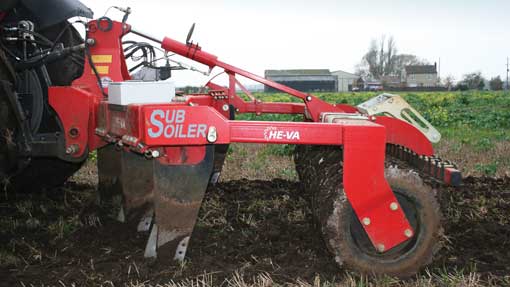Cultivator autodepth system set to take off

Precision farming technology is coming to cultivations. The development of auto control to match tine penetration to soil compaction depth gathers pace, reports Peter Hill.
At next week’s Tillage-Live event a demo will take place of automatic cultivator depth control by precision farming specialist SOYL, as part of the Knowledge Trail. It will coincide with the event debut of implement maker Cultivating Solutions and its smart cultivator.
The two companies are co-operating in the commercialisation of SOYL’s auto-depth controller for subsoilers and other cultivations equipment and complements Yorkshire-based Cultivating Solutions’ aim to develop novel approaches to tillage equipment.
“As luck would have it, our RapidLift deep soil-loosening module for cultivator drills and our Titan tine and disc cultivator are ideal for automatic depth control,” says Richard Scholes. “The soil loosening tines on both implements are mounted on a parallel linkage so changing the working depth has no impact on the angle of the tines and points or their effectiveness in re-structuring the soil.”
Read more: How even heavy machinery can ease soil compaction
The Titan “smart cultivator” planned for the event will have touch-screen control of the different elements of the multi-stage implement, which deploys straight-cutting discs ahead of the low disturbance tines, two rows of angled discs giving intensive shallow cultivation and a packer roller.
“We’re really working towards an implement that allows you to do whatever you want, wherever you want,” says Mr Scholes. “The electronic control terminal will provide easy manual adjustment of working elements or automatic control.”
CUTTING FUEL USE
SOYL’s technical manager David Whatoff reckons growers can make useful fuel cost savings through soil compaction mapping and automatic cultivator depth control. He points out that an increase in cultivation depth of only 50mm can almost double the draft forces involved.
Working deeper than necessary to break through compacted layers that restrict water movement and root development therefore incurs unnecessary costs – while going too shallow, of course, means expenditure on soil loosening is wasted.
“As part of our research, we mapped the depth of compacted soil layers within fields using GPS and a penetrometer to evaluate to what extent different soil textures have structures that compact differently,” Mr Whatoff explains.
A clay soil, which is naturally strong, will tend to compact at a shallower depth than a sand soil that is inherently weaker, he points out. Cultivating them both at the same depth is therefore inefficient and potentially expensive.
Commercial mapping using an ATV-mounted penetrometer to record soil resistance in 25mm steps down to 600mm is the most intensive approach, and probably most suited to root crop growers, he suggests.
“Alternatively, growers could use soil texture maps as a guide to take measurements using a hand-held penetrometer or a spade to identify optimum cultivation depth in each soil type zone,” says Mr Whatoff.
Either way, the treatment map is uploaded to SOYL’s Autodepth controller package, which was first developed and trialled using a tractor-mounted subsoiler, on which the rear packer roller regulated working depth of the tines.
PARALLEL LINKAGE
On Cultivating Solutions implements, the Autodepth system can regulate the depth of the soil loosening legs from zero (with the legs lifted clear of the ground) to 300mm deep.
The RapidLift legs are mounted on a parallel linkage, so the angle of points and wings remains constant and altering their working depth has no impact on the seed drill or the other elements of the Titan cultivator.
SOYL customers can access their compaction, soil texture and weed population maps through the company’s website and generate cultivation plans to control their implement.
Once in the field, settings can be over-ridden where local conditions – such as a wet patch – demand adjustment of the working depth.
The controller can be fitted to existing RapidLift and Titan implements and is an option on new ones.
“We expect the greatest uptake to be for the RapidLift tractor-mounted and seed drill modules and believe there is great potential to increase margins, particularly for oilseed rape,” says Richard Scholes. “It’s a good opportunity for SOYL customers to get more out of their maps for a comparatively small investment.
THREE UNITS ON TEST
It seems growers taken with the technology are already thinking of different ways of using it.
“We have three implements working on-farm with Autodepth control this autumn, but only one of them will be used for full variable working depth using a RapidLift module on a drill,” explains Mr Scholes.
“Another RapidLift will be used with the system to provide depth control over undulating ground – say 250mm in valley bottoms where the soil is deeper and 150mm on the hills where it is shallower.”
On a Titan cultivator, Autodepth will be used as a headland management system, automatically lifting and lowering the tines, then discs and packer under GPS control.
“It will be a good way of testing the technology before applying it to variable depth cultivation across the field,” says Richard Scholes.

